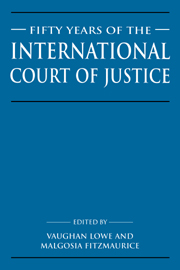Book contents
- Frontmatter
- Contents
- List of contributors
- Preface
- List of abbreviations
- Sir Robert Yewdall Jennings, by Vaughan Lowe
- List of publications of Sir Robert Jennings
- Table of cases
- Part I The International Court of Justice
- Part II The sources and evidences of international law
- Part III Substance of international law
- Part IV Procedural aspects of the work of the International Court of Justice
- 21 Procedural law and the International Court of Justice
- 22 The President of the International Court of Justice
- 23 Nationality of claims: some relevant concepts
- 24 The plea of domestic jurisdiction before the International Court of Justice: substance or procedure?
- 25 ‘Partial’ judgments and the inherent jurisdiction of the International Court of Justice
- 26 Intervention before the International Court of Justice
- 27 The use of Chambers of the International Court of Justice
- 28 The use of experts by the International Court of Justice
- 29 Provisional measures
- 30 Remedies in the International Court of Justice
- 31 A comment on the current health of Advisory Opinions
- Part V The International Court of Justice and the United Nations
- Index
23 - Nationality of claims: some relevant concepts
Published online by Cambridge University Press: 02 November 2009
- Frontmatter
- Contents
- List of contributors
- Preface
- List of abbreviations
- Sir Robert Yewdall Jennings, by Vaughan Lowe
- List of publications of Sir Robert Jennings
- Table of cases
- Part I The International Court of Justice
- Part II The sources and evidences of international law
- Part III Substance of international law
- Part IV Procedural aspects of the work of the International Court of Justice
- 21 Procedural law and the International Court of Justice
- 22 The President of the International Court of Justice
- 23 Nationality of claims: some relevant concepts
- 24 The plea of domestic jurisdiction before the International Court of Justice: substance or procedure?
- 25 ‘Partial’ judgments and the inherent jurisdiction of the International Court of Justice
- 26 Intervention before the International Court of Justice
- 27 The use of Chambers of the International Court of Justice
- 28 The use of experts by the International Court of Justice
- 29 Provisional measures
- 30 Remedies in the International Court of Justice
- 31 A comment on the current health of Advisory Opinions
- Part V The International Court of Justice and the United Nations
- Index
Summary
The ‘nationality of claims’ rule is, on the face of it, beguilingly clear and simple. It requires that a state instituting international legal proceedings against another state in respect of damage which that other state has caused to a private person must show that that person possesses its nationality.
The rule is well established in customary international law, and is of pivotal importance for the whole process whereby states may be held responsible for acts causing damage to private persons. Its underlying rationale was set out by the PCIJ in the Panevezys–Saldutiskis Railway case, where it said that ‘in taking up the case of one of its nationals … a State is in reality asserting its own right … This right is necessarily limited to intervention on behalf of its own nationals because, in the absence of a special agreement, it is the bond of nationality between the State and the individual which alone confers upon the State the right of diplomatic protection.’
The rule underlies every case in which a state institutes proceedings in the ICJ in respect of damage done to a private person at the hands of the respondent state. In most cases its requirements cause no real difficulty. In three, however, its application has been particularly significant – the Advisory Opinion on Reparations for Injuries Suffered in the Service of the United Nations, and the judgments in the Nottebohm case, and the case concerning the Barcelona Traction, Light and Power Company Limited.
- Type
- Chapter
- Information
- Fifty Years of the International Court of JusticeEssays in Honour of Sir Robert Jennings, pp. 424 - 439Publisher: Cambridge University PressPrint publication year: 1996
- 1
- Cited by



